
Compiled by Marc M
e-mail
Copyright (©) 1997-2010 All Rights Reserved
Okay to download and print for your own use. Please refer other interested
parties to this website.
This site is no longer actively maintained.

Compiled by Marc M
e-mail
Copyright (©) 1997-2010 All Rights Reserved
Okay to download and print for your own use. Please refer other interested
parties to this website.
This site is no longer actively maintained.
![]()
In 1890 a sawmill on Gulf Stream in
Rodman![]() sawed two hundred thousand feet of lumber that year. A sawmill built on
Dish
sawed two hundred thousand feet of lumber that year. A sawmill built on
Dish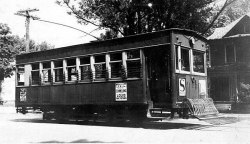 Creek a mile west of
Rodman made six hundred thousand shingles a year.
Adam's village had a population of 1500 and in 1891. Remington Brothers
built the first streetcar line from
Watertown
to Brownville, and five years later extended it to Dexter
Creek a mile west of
Rodman made six hundred thousand shingles a year.
Adam's village had a population of 1500 and in 1891. Remington Brothers
built the first streetcar line from
Watertown
to Brownville, and five years later extended it to Dexter![]() .
Watertown's first electric trolley service started and a new post office
was also opened in that year on Arsenal Street.
.
Watertown's first electric trolley service started and a new post office
was also opened in that year on Arsenal Street.
Roswell P. Flower was elected governor of
New
York State in 1891. He had been born 54 years before in Theresa![]() ,
where his father died when he was eight years old. He had been forced to
go to work at that time and get his schooling whenever he could. Flower
worked his way up from there and was known as being one of the shrewdest
operators on Wall Street, still keeping a residence in Watertown. The residence
had much rare furniture, some of which James D. Le Ray had brought from
Paris.
,
where his father died when he was eight years old. He had been forced to
go to work at that time and get his schooling whenever he could. Flower
worked his way up from there and was known as being one of the shrewdest
operators on Wall Street, still keeping a residence in Watertown. The residence
had much rare furniture, some of which James D. Le Ray had brought from
Paris.

Caroline Charlotte Bonaparte Benton, Joseph
Bonaparte's (brother of Napoleon) daughter, died in comparative poverty
on Christmas Day, December 25, 1890 in Richfield Spring, NY. A small monument
in Oxbow is all that shows where she is buried. She moved to Oxbow![]() in July of 1939 after marrying Zebulon Howell Benton, son of a local physician,
and the family was considered wealthy by local standards. When
they got
married it was at that time the most elaborate marriage ever in the area. But after the fall of
Caroline's cousin, Napoleon III, her pension stopped and
she had to give French and music lessons to students in Watertown, Utica, and
then Richfield
Springs, where she died.
in July of 1939 after marrying Zebulon Howell Benton, son of a local physician,
and the family was considered wealthy by local standards. When
they got
married it was at that time the most elaborate marriage ever in the area. But after the fall of
Caroline's cousin, Napoleon III, her pension stopped and
she had to give French and music lessons to students in Watertown, Utica, and
then Richfield
Springs, where she died.
About 1891 a recreational center was built across
from what is now Glen Park![]() and on the opposite side of the river. This was known as the "Coney Island
of the North Country" and had been built by the Watertown and Brownville Street
Railway Company, headed by Lincoln G. DeCant. An iron bridge was
built across the river and the amusement park itself was built in a grove of trees,
making a natural amphitheater. The hillside was terraced and seats were
placed there, and then in 1895 a pavilion fifty feet by a hundred was built. The
Red and Black football team played there until it moved its games to the
fairgrounds in Watertown. Caves under the park also were a big attraction, with floors
being built in them as well as stairs and electric lights strung. Traveling
shows stopped there and the Watertown city band played there. A cable
was strung over the river and a tightrope artist performed his act over
the running waters. Also a total of thirty marriages were performed in the caves over the
years.
and on the opposite side of the river. This was known as the "Coney Island
of the North Country" and had been built by the Watertown and Brownville Street
Railway Company, headed by Lincoln G. DeCant. An iron bridge was
built across the river and the amusement park itself was built in a grove of trees,
making a natural amphitheater. The hillside was terraced and seats were
placed there, and then in 1895 a pavilion fifty feet by a hundred was built. The
Red and Black football team played there until it moved its games to the
fairgrounds in Watertown. Caves under the park also were a big attraction, with floors
being built in them as well as stairs and electric lights strung. Traveling
shows stopped there and the Watertown city band played there. A cable
was strung over the river and a tightrope artist performed his act over
the running waters. Also a total of thirty marriages were performed in the caves over the
years.
What is thought to be the first Italian family came
to Watertown around 1890, the Gaetano Campini family. The Brownville Paper Company was organized
in September of 1892 by J. Munson Gamble and Charles H. Remington, and the
company was incorporated the next year. The New York Central Railroad absorbed
the rail link at
Sackets Harbor![]() ,
incorporating it into one of the world's most extensive rail systems in
1893. In the same year Glen Park
,
incorporating it into one of the world's most extensive rail systems in
1893. In the same year Glen Park![]() was incorporated. Glen Park had previously been known as Jim Wood's Falls,
named after an original settler who came from New Hampshire in 1804. Jim
Wood and his sons built a large two-story stone building which is still
standing. Glen Park took its name from the amusement park across the river.
was incorporated. Glen Park had previously been known as Jim Wood's Falls,
named after an original settler who came from New Hampshire in 1804. Jim
Wood and his sons built a large two-story stone building which is still
standing. Glen Park took its name from the amusement park across the river.
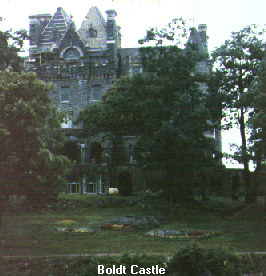 In the summer of 1893 George Boldt and his family (Louise; his wife,
and their children; Louise Clover [age 11], and George Jr. [age 15]) spent
a weekend in
Alexandria Bay and returned the following year. Mr. Elizur Kirke Hart,
owner of Hart Island, died in 1893 and his extensive summer "cottage" remained
unoccupied for several years. But a few years later in July of 1895, Boldt
bought Hart (later Heart) Island, though it was deeded in Louise Boldt's name (was originally
Hemlock Island and then renamed "Hart" Island by Mr. Hart). The island
consisted of about five acres not too far off
Alexandria Bay
In the summer of 1893 George Boldt and his family (Louise; his wife,
and their children; Louise Clover [age 11], and George Jr. [age 15]) spent
a weekend in
Alexandria Bay and returned the following year. Mr. Elizur Kirke Hart,
owner of Hart Island, died in 1893 and his extensive summer "cottage" remained
unoccupied for several years. But a few years later in July of 1895, Boldt
bought Hart (later Heart) Island, though it was deeded in Louise Boldt's name (was originally
Hemlock Island and then renamed "Hart" Island by Mr. Hart). The island
consisted of about five acres not too far off
Alexandria Bay![]() ,
and held a large wooden and granite cottage. The cottage was a towered building
with eighty rooms, which Boldt remodeled. The family spent the next couple
summers on the island and Boldt modified the shape of the island to look
more like a heart. Other buildings were also built on the island, including
a large stone arch called the Arch of Honor, a covered dock, six more summer
homes, a number of flower gardens, a gazebo, a hennery, dog kennels, and
the Alster Tower.
,
and held a large wooden and granite cottage. The cottage was a towered building
with eighty rooms, which Boldt remodeled. The family spent the next couple
summers on the island and Boldt modified the shape of the island to look
more like a heart. Other buildings were also built on the island, including
a large stone arch called the Arch of Honor, a covered dock, six more summer
homes, a number of flower gardens, a gazebo, a hennery, dog kennels, and
the Alster Tower.
The Smith Building in
Watertown
was built in 1895, and later became the Mohican Building. Also in
the same year a village water system was installed in
Cape Vincent![]() and in Watertown James B. Wise was elected mayor. (Click
here for a map of 1895 Jefferson County, NY from The Livingston County Michigan
USGenWeb project) Around 1895 a Jewish cemetery was established
at Huntingtonville. On March 4, 1896, the West
Carthage Fire
and in Watertown James B. Wise was elected mayor. (Click
here for a map of 1895 Jefferson County, NY from The Livingston County Michigan
USGenWeb project) Around 1895 a Jewish cemetery was established
at Huntingtonville. On March 4, 1896, the West
Carthage Fire![]() Department was organized with David Trembly as the first chief. Also
in the same year a steam-operated fog whistle was added to the Tibbets Point
Lighthouse
Department was organized with David Trembly as the first chief. Also
in the same year a steam-operated fog whistle was added to the Tibbets Point
Lighthouse![]() .
.
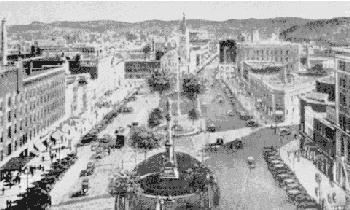 Between 1898 and 1901 the Ninth U.S. Infantry, stationed at
Sackets Harbor
Between 1898 and 1901 the Ninth U.S. Infantry, stationed at
Sackets Harbor![]() ,
fought in Cuba and the Philippines during the Spanish American War, and
in China during the Boxer Rebellion. The suspension bridge over the north
channel of Black River in
Watertown
was replaced with a steel arch bridge during Mayor James B. Wise' (The
J.B. Wise Parking Lot behind the Square is named after the mayor)
administration. He also had the City Hall built, Public Square
paved (around 1894) , and helped Watertown increase its interest in football as well
as increasing its business in the city.
,
fought in Cuba and the Philippines during the Spanish American War, and
in China during the Boxer Rebellion. The suspension bridge over the north
channel of Black River in
Watertown
was replaced with a steel arch bridge during Mayor James B. Wise' (The
J.B. Wise Parking Lot behind the Square is named after the mayor)
administration. He also had the City Hall built, Public Square
paved (around 1894) , and helped Watertown increase its interest in football as well
as increasing its business in the city.
In 1898 the W.S. Rice Company moved to Adams![]() . The company expanded and stayed in business for seventy-five years. At first
only trusses were made, but later foundation garments were manufactured
there. In 1899 City Hospital, later to become the House
of the Good Samaritan, had a horse-drawn ambulance on the road.
This was right before they moved from their location at TenEyck and Holcomb
Streets to their present location on Washington Street.
. The company expanded and stayed in business for seventy-five years. At first
only trusses were made, but later foundation garments were manufactured
there. In 1899 City Hospital, later to become the House
of the Good Samaritan, had a horse-drawn ambulance on the road.
This was right before they moved from their location at TenEyck and Holcomb
Streets to their present location on Washington Street.
Around 1900 Watertown was one of the leaders in Pro Football. A team had been organized in 1896 and by 1900 became the Red and Black Team, which was known as one of the best in the country. Alex Duffy was born in "the flats", the west side of Watertown where many of the Irish settled. Mr. Duffy is one of the best-known Watertown citizens.
The turn of the century also saw bicycles become all the rage in Watertown, there being an estimated one thousand of them in the city. Some horseless carriages also began to make their appearances in the North Country. No one knows exactly for sure who had the first one but L.G. Grant was credited with driving a Stanley Steamer from Cape Vincent to Watertown in only thirteen hours. There is some debate as to whether Grant or Louis W. Moore may have had the first car in the city.
Also by the 1900's Watertown's police force had grown to forty-five men and around the turn of the century Thompson Park, located on Pinnacle Hill, was donated to Watertown by John C. Thompson. Originally there was a large and very popular wading pool where the water tower is now standing. The park was designed by the Olmstead Brothers, who designed New York City's Central Park and Boston's Park. The park today includes five hundred-thirteen acres of land at the southeast edge of the city and the Thompson Park Conservancy continues to change and add to the zoo, situated in the park. A public swimming pool, tennis courts, walking and riding trails (one named after the Olmsteads), a playground and an eighteen-hole private golf course are also in the Thompson Park.
 In 1900 the Adams Free Library was created by the Study Club, led by Mr.
and Mrs. Brenton D. Babcock and around eight hundred and eighteen books were
received. And also in 1900, then governor Theodore Roosevelt visited
Watertown
for a Republican Party gathering, and inn 1901 the Thousand Island Sun was started. Sculptor
Augustus St. Gaudens' bronze statue of Governor Roswell P. Flower
was unveiled on September 1, 1902 in Watertown. The Rothstock, now called
Empsalls, was built in 1903 in Watertown and changed to Empsalls in 1907. The building was considered
Watertown's
first "skyscraper". In 1906 the Hotel LeRay was built by the LeRay Realty
Corporation.
In 1900 the Adams Free Library was created by the Study Club, led by Mr.
and Mrs. Brenton D. Babcock and around eight hundred and eighteen books were
received. And also in 1900, then governor Theodore Roosevelt visited
Watertown
for a Republican Party gathering, and inn 1901 the Thousand Island Sun was started. Sculptor
Augustus St. Gaudens' bronze statue of Governor Roswell P. Flower
was unveiled on September 1, 1902 in Watertown. The Rothstock, now called
Empsalls, was built in 1903 in Watertown and changed to Empsalls in 1907. The building was considered
Watertown's
first "skyscraper". In 1906 the Hotel LeRay was built by the LeRay Realty
Corporation.
Roswell P. Flower died in 1899 and three years later a monument to Flower was erected in Watertown (recently it was restored). His daughter, Mrs. Emma Flower Taylor, donated to the city the Flower Memorial Library in honor of her father around 1904. In 1903 Samuel Anzalone opened the first spaghetti factory in Northern New York at 840 Coffeen Street, Watertown (see Art's Jug history for more info).
Also in 1899 George Boldt decided to build a castle on his island and present it to his wife, Louise, on her birthday, Valentine's Day. The castle, begun in 1900, would be modeled after a castle on the Rhine and would be built by only the best craftsman. Before long the old cottage was moved across the ice to Wellesley Island where it still exists as a bed and breakfast. The Power House Building and clock were built, while the family spent their summers in the Alster Tower.
In January, 1904 Boldt Castle was almost complete when a telegram was sent to the workers for them to stop all work. Louise died just one month before her birthday. Over three hundred workers stopped work and left. Rumor was that George Boldt never came back to the island; he subsequently died on December 5, 1916 at the Waldorf-Astoria Hotel. Upon his death ownership of the island passed jointly to George Boldt's only son and daughter - George Boldt, Jr. and Louise Clover Boldt Miles.
In October or November of 1904 a man by the name of
Spano killed another man
in the area, and it was believed that this was Mafia-related.
The first breakwater in
Cape Vincent![]() was started and completed in 1906. The breakwater was repaired and
resurfaced in 1983. Electric lights were installed in
Cape Vincent in 1903. In 1905 Watertown developed two hundred
acres for the park.
Watertown's
first motion picture theater was opened in 1907 and called the Wonderland.
Around the same year the Township Telephone Company of Chaumont
was started and completed in 1906. The breakwater was repaired and
resurfaced in 1983. Electric lights were installed in
Cape Vincent in 1903. In 1905 Watertown developed two hundred
acres for the park.
Watertown's
first motion picture theater was opened in 1907 and called the Wonderland.
Around the same year the Township Telephone Company of Chaumont![]() was organized and incorporated the next year.
was organized and incorporated the next year.
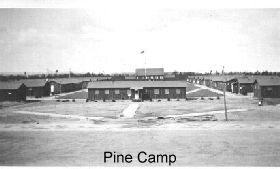 In the early 1900's the U.S. Army established Pine Plains (Pine
Plains is roughly a triangle of land around 8 miles long and about 4
miles wide), later
known as Pine Camp (Madison Barracks and other military
units of the US needed a training area), eleven miles east of
Watertown.
Brigadier General Frederick Dent Grant, son of General Ulysses S. Grant,
was sent with two-thousand regulars and eight-thousand militia. Grant decided
that it was an ideal place to train land troops and the next year money
was allocated to purchase the land. The post was later renamed
Camp Hughes, then Camp Drum
and today is called
Fort Drum
In the early 1900's the U.S. Army established Pine Plains (Pine
Plains is roughly a triangle of land around 8 miles long and about 4
miles wide), later
known as Pine Camp (Madison Barracks and other military
units of the US needed a training area), eleven miles east of
Watertown.
Brigadier General Frederick Dent Grant, son of General Ulysses S. Grant,
was sent with two-thousand regulars and eight-thousand militia. Grant decided
that it was an ideal place to train land troops and the next year money
was allocated to purchase the land. The post was later renamed
Camp Hughes, then Camp Drum
and today is called
Fort Drum![]() (see later in this history for more info). On August 31, 1907 the first
training was done on Pine Plains, about a mile from Evans Mills. {Pine Camp picture courtesy of Francis and Dawn Prievo}
(see later in this history for more info). On August 31, 1907 the first
training was done on Pine Plains, about a mile from Evans Mills. {Pine Camp picture courtesy of Francis and Dawn Prievo}
In 1910 the area's first auto show was held at the State Armory on Arsenal Street and Thomas A. Edison drove through Watertown on his way to the St. Lawrence River. Robert A. Taft, the president's son, was also vacationing in the islands at this time. Jack Dallas and his yellow dirigible, then called an airship, were big attractions at the county fair. Also around 1910 the Chaumont Volunteer Fire Department was started, but actually organized and incorporated in October of 1914.
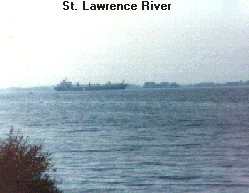 Sometime in 1908 Sarah Brennan, 54, owned two houses side-by-side on Paddy
Hill, which is on the south side of the Black River and opposite the bridge
in Brownville. Her tenants were James and Mary O'Sullivan Farmer. One day,
James Brennan came home and couldn't find his wife, so he asked his tenant,
Mary Farmer - a slight woman with partial facial paralysis, and was
told by her that his wife had sold both houses to Mrs. Farmer and left town
with the money. Mrs. Farmer showed Mr. Brennan a deed which showed that
the deal had been done and recorded at the office of the Jefferson County
Clerk. The Farmers' then evicted Mr. Brennan and moved all their things
into the former Brennan residence. But Mr. Brennan went to the sheriff and
demanded an investigation, which prompted the sheriff to go to the Farmer's
house and search it. He found a large locked trunk and demanded the key.
Mary Farmer refused to unlock it, so it was broken open. Inside they found
the body of Mrs. Brennan stuffed into it, Mrs. Brennan had been killed with
an axe. The Farmer's were arrested and charged with capital murder. During
the trial, it was shown that Mary Farmer had gone to the county clerk's
office and claimed to be Sarah Brennan, at which point the clerk's office
transferred the property. Both of the Farmers were found guilty with James
Farmer charged as an accessory and Mary sentenced to death. At the last
minute, Mary Farmer confessed that her husband didn't know anything about
the crime. He was freed based only on her word. On March 29, 1909, Mary
Farmer died in the electric chair in Auburn prison. She was the first woman
to die in the electric chair in New York, the second woman to be executed
in the state, and the only one from Jefferson County.
Sometime in 1908 Sarah Brennan, 54, owned two houses side-by-side on Paddy
Hill, which is on the south side of the Black River and opposite the bridge
in Brownville. Her tenants were James and Mary O'Sullivan Farmer. One day,
James Brennan came home and couldn't find his wife, so he asked his tenant,
Mary Farmer - a slight woman with partial facial paralysis, and was
told by her that his wife had sold both houses to Mrs. Farmer and left town
with the money. Mrs. Farmer showed Mr. Brennan a deed which showed that
the deal had been done and recorded at the office of the Jefferson County
Clerk. The Farmers' then evicted Mr. Brennan and moved all their things
into the former Brennan residence. But Mr. Brennan went to the sheriff and
demanded an investigation, which prompted the sheriff to go to the Farmer's
house and search it. He found a large locked trunk and demanded the key.
Mary Farmer refused to unlock it, so it was broken open. Inside they found
the body of Mrs. Brennan stuffed into it, Mrs. Brennan had been killed with
an axe. The Farmer's were arrested and charged with capital murder. During
the trial, it was shown that Mary Farmer had gone to the county clerk's
office and claimed to be Sarah Brennan, at which point the clerk's office
transferred the property. Both of the Farmers were found guilty with James
Farmer charged as an accessory and Mary sentenced to death. At the last
minute, Mary Farmer confessed that her husband didn't know anything about
the crime. He was freed based only on her word. On March 29, 1909, Mary
Farmer died in the electric chair in Auburn prison. She was the first woman
to die in the electric chair in New York, the second woman to be executed
in the state, and the only one from Jefferson County.
Around 1908 Dennis Guilfoyle developed some land on Stone Street, using horse-drawn hearses as ambulances. He had black horses and white horses; of which the black were used when the hearse was carrying out it's intended job, the white ones being used when the hearse was doubling as an ambulance.
In 1910 the U.S. Lighthouse Board was disbanded, during
the 1880's lighthouses were under the control of the Lighthouse Board which
was part of the US. Treasury Department. Naval and Army Corps of Engineer
officers were assigned to the board and ran the districts, when the
board was disbanded a civilian Bureau of Lighthouse was formed. For more
then a half century the Mononna family kept the Tibbets Point Lighthouse![]() running.
running.
By 1911 the F.W. Woolworth Company owned five hundred
and ninety-six five-and-ten-cent stores and the company was incorporated. In 1913 the company erected the
Woolworth Building in New York City, which
at the time was the world's tallest building. Also, in the same year, a large
fire wiped out the burgeoning industry in Felts Mills, and another the next
year did the same.
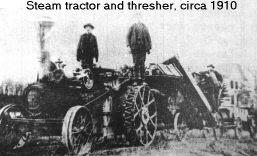
The Frontenac Hotel burned in 1911. Franklin D. Roosevelt,
Assistant Secretary of the Navy, visited Sackets Harbor in 1913 to dedicate
a monument at the
Sackets Harbor![]() Battlefield to those who served in the War of 1812. From 1917 to 1918 Madison
Barracks trained officers for service in World War I. As many as two thousand
five-hundred men were stationed there during that period. And from 1918
to 1919 Madison Barracks was used as a hospital for shell-shocked veterans
and other World War I wounded.
Battlefield to those who served in the War of 1812. From 1917 to 1918 Madison
Barracks trained officers for service in World War I. As many as two thousand
five-hundred men were stationed there during that period. And from 1918
to 1919 Madison Barracks was used as a hospital for shell-shocked veterans
and other World War I wounded.
In 1912 William Button became Watertown's first motorcycle cop. Around July of 1914 Dennis Guilfoyle bought an automobile funeral car, a 35-HP Overland, the first self-propelled funeral car in Watertown. He said that it would also be used as an ambulance when needed, but he kept his horse-drawn hearses too.
In February of 1918 the site of the current Children's Home of Jefferson County was bought, though the actual current name was not adopted until 1930. During the same year a bad influenza epidemic broke out in Watertown.
The American Legion Post Number 832 was built in 1919
in
Cape Vincent![]() .
Frank W. Woolworth died with a sixty-five million-dollar fortune. Also in
1919 Robert Lansing, the only Watertown resident to serve in the
president's cabinet, delivered a dedicatory address on September 20 for
Lansingdorp. Lansingdorp was a government housing development for workers
and their families who came to the city for war work. The housing was named
in honor of Lansing, and was built on land which originally was part of
the old Lansing farm.
.
Frank W. Woolworth died with a sixty-five million-dollar fortune. Also in
1919 Robert Lansing, the only Watertown resident to serve in the
president's cabinet, delivered a dedicatory address on September 20 for
Lansingdorp. Lansingdorp was a government housing development for workers
and their families who came to the city for war work. The housing was named
in honor of Lansing, and was built on land which originally was part of
the old Lansing farm.
In mid-June of 1919 a suffrage parade was held in Watertown (the first). The parade, accompanied by a female drummer and organized by “General” Rosalie Jones, started with four women all dressed in yellow but attracted others along the route. At the end of the route a number of speeches were presented and an editorial applauding women's voting rights appeared in the Watertown Daily Times. A year earlier in 1918 New York State had allowed women to vote in state-related elections, and in fact in that year's village elections more women then men voted in the village of Carthage. In Sackets Harbor Republican Anna McQuaid Mason was elected mayor by a fifteen-vote margin. Later in 1919 the national women’s suffrage amendment passed the House of Representatives.
1920 saw the "city manager" form of government adopted and the Olympic Theater was built during this year. It had a symphony orchestra which gave concerts before each show. Watertown's population leveled off at about thirty-two thousand. It was said that during this time the greatest number of paper mills in the world resided along Black River. Also during this time of the 1920's, the Paddock Mansion was bequeathed to the Jefferson County Historical Society by Mrs. Edwin L. (Olive) Paddock and the building was made into a museum. During the 20's and 30's Watertown's police force was modernized with tommy guns, squad cars, and new motorcycles.
In
Clayton![]() during 1920, bus line owner Fred Dailey dared tire shop owner Carl Frink
to make a plow that would safely clear snow along his bus route from
Clayton to
Watertown. Later that year and during that winter, Dailey cleared the highway from
Clayton to
Watertown
for his buses with Frink's new steel plow fastened to the undercarriage
of his Duplex truck. Word of the new plow spread and orders came in; first
locally, then from across the state, then from across the country and later
from around the world. The early plows were hung from the undercarriage
of trucks, and even cars. This was a major advance but still was not good
enough. Eventually Frink developed equipment capable of tackling the deepest
snow accumulations. The original factory burned in 1960. (More
Frink Plow pictures here. Above picture courtesy of
Rene
Elliott)
during 1920, bus line owner Fred Dailey dared tire shop owner Carl Frink
to make a plow that would safely clear snow along his bus route from
Clayton to
Watertown. Later that year and during that winter, Dailey cleared the highway from
Clayton to
Watertown
for his buses with Frink's new steel plow fastened to the undercarriage
of his Duplex truck. Word of the new plow spread and orders came in; first
locally, then from across the state, then from across the country and later
from around the world. The early plows were hung from the undercarriage
of trucks, and even cars. This was a major advance but still was not good
enough. Eventually Frink developed equipment capable of tackling the deepest
snow accumulations. The original factory burned in 1960. (More
Frink Plow pictures here. Above picture courtesy of
Rene
Elliott)
The six-story Woolworth Building was built in 1921 and in 1925 the Thompson Park swimming pool was opened. The city bought land for the Watertown Municipal Airport in 1928, and more land in 1942 and 1943.
On June of 1922 the Boldt estate, which included Heart Island and all structures on it, was sold to Mr. Edward J. Nobel, President of the Beech Nut Foods Company (who make Lifesavers) and Mr. Alfred Graham Miles, the husband of George Boldt's daughter, Louise. In June of 1924 Mr. Nobel purchased full interest in the Boldt estate.
Around 1923 to 1923 the Daegel Israel Jewish Cemetery was established, near the Glenwood Cemetery. Sometime in 1925 the Army added an anti-aircraft practice range (including "pillboxes" which can still be seen - pictures and info at my site here) to the existing rifle practice range on Stony Point. Later a concrete road was added but soon after (1946) the whole range was declared surplus and sold (this info from the Henderson Historical Society's website).
In 1926 W. Gilbert Freeman organized a private company and sought legislation to authorize a project to built a bridge linking the US and Canada in the 1000 Islands Region. It was vetoed but a large movement was organized by local citizens of the area, and traveled via a special train from Clayton to Albany. But the bridge bill was still turned down and finally Freeman gave up his efforts in 1931.
Sometime in 1927 the steam-operated fog whistle was replaced at Tibbets Point Lighthouse by an air diaphone on a timer operated by a diesel engine, and could be heard for four to five miles and sometimes more. The first airplane taxi service was started in the area too, as well the first municipal hydro-electric power plant in Watertown.
In 1929 The Depression hit and thirty-eight paper mills in the area shut down. The bridge over the north channel of Black River was constructed. (Click here for a 1929 Atlas of the State of New York by Simeon DeWitt, Surveyor General by David S. Burr - on the Jefferson County Genweb page.) March 9, 1929 a large manhunt for three escapees from Auburn Prison was concluded when two of the prisoners were caught by Sheriff's, the next day the last one was captured.
In 1930 MetroGoldwynMeyer, Fox, Paramount and Pathe filmed the maneuvers of the Seventh Field Artillery and the Twenty-Eighth Infantry on the ice of Lake Ontario. Also in the 1930's, Frink snowplows of Clayton became the largest highway snowplow manufacturer in the U.S.
Walter Blanchard cleaned out the debris in the Natural Bridge Caverns in the 1930's, working with only a team of oxen, and opened the caverns for flat-bottomed boat rides. The caverns were carved by the Indian River millions of years ago as it dug its way underground through the limestone. The river reappears after a distance and forms a natural bridge, hence the name.
In 1930 electrical lights were installed at Tibbets Point Lighthouse, sixty one candle power lights were used and designated "fourth order" flashing white with a characteristic of 10 seconds, 6 seconds, with 4 seconds eclipse.
During the summer of 1932 the effort to build a bridge from the 1000 Islands Region to Canada was revived as a work relief project. A citizens committee was formed and led by William T. Field, a Watertown civil engineer. But the real force behind the effort was Russell Wright, a Watertown lawyer who later became an assemblyman and judge. Finally in 1933 the 1000 Islands Bridge Authority was formed and in the following year Canada formed their own version. Eventually the whole project was designated to the U.S. 1000 Islands Bridge Authority, due to various financing and investment banker issues. During and before the building of the bridge itself, much hardship was involved in securing right-of-ways or property rights from those who's land the bridge building would include.
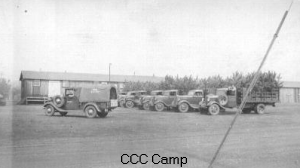
In 1932, the Depauville Fire District was created and 1933 saw a camp of the Civilian Conservation Corps, a Depression Era mobilization of young men to carry out environmental projects, established at Madison Barracks in Sackets Harbor. (For some more pictures see my Historical Pictures Page.)
In 1934 Madison Barracks became the headquarters for ten CCC (civilian conservation corps) Camps in the region. The horses and mules of the field infantry at Madison Barracks were replaced by trucks in 1934 to 1935. Also in 1935 Pine Plains (later Fort Drum) gained national attention when the largest peacetime maneuvers ever held in the US took place on Pine Plains and the surrounding area. Over thirty-six thousand troops participated in the maneuvers and some were arriving by train every fifteen minutes, coming from as far away as New York City. The exercise continued for thirty-six hours on the hundred or so miles of land the Army had leased. After the great success of this exercise the military purchased another nine-thousand acres.
County Judge Crandall F. Phillips, an avid local spelunker (cave-explorer), investigated the vast caves under Watertown around 1935 or so. He discovered "1809" written on one of the cavern walls when it had been formerly recorded that the first exploration into the caves was in 1822. On another of Phillips' trip into the caves Ernest C. Gould, who was with the judge on this occasion, was approximately fifteen-hundred feet back from the entrance when he found a corked bottle containing a slip of paper dated June 1, 1911 with the names Roy Carter, Charles Babcock and John W. Bragger. Large chambers fifteen feet high were found by that expedition, which estimated that they went as far back as Hillside Avenue. The North Side or Moulton Street Cave was said to have a passage or passages, now blocked by fallen stone, running under the river and connecting with the caverns beneath Public Square, ending in the southeasterly side of it. On the south side of Newell Street, which used to be River Street, and located between Mill and Court Streets is the once long-used "Beer" or "Ice" cave where a local beer company stored beer for many years. In this cave it was said that the ice never melted until September and in mid-winter it began to freeze again.
Around 1935 the House of the Good Samaritan retired their horse-drawn ambulance for a used 1927 hearse donated by Wilcox & VanNess funeral home. Around 1935 a C.C. Camp was started in Lorraine to improve streams and develop fire trails. (See pictures at Old Photos of the area.) Between 1934 and 1942 the Clayton Casino operated.
The United States subchaser, S.C. 431, exploded at anchor off Navy Point in 1937, wounding Chief Petty Officer Steven Kafka, who died three days later. In 1938 streetcar services in Watertown were discontinued.
 In little more then a year the
Thousand Islands Bridge was built from what was then
Collins Landing,
to Wellesley Island, and then to Ontario; an idea wished upon for many years.
It was formally dedicated by President Franklin D. Roosevelt and
Canada's Prime Minister W.L.M. King on a warm, sunny day on August
18, 1938. The ribbon-cutting ceremony at the international border on
the bridge was witnessed by 25,000 people. The bridge links New York
State with Ontario, Canada, and consists of two lanes on five island-hopping
spans. It was designed by the New York engineering firm of Robinson
and Steinman (later known as Steinman, Boynton, Gronquist, and London),
and built for less then $3,000,000. Most of the workers were Mohawk
Indians, some of who's ancestors walked the same lands and traveled
the river. The US span is eight-hundred feet between towers, a hundred
fifty feet above water, and has two one-thousand foot viaducts. The
three Canadian spans include a suspension span seven-hundred fifty feet
between towers, a hundred-twenty feet above water, and a one-thousand five
hundred foot viaduct, a steel arch span three-hundred forty eight feet long,
and a Warren Truss span six-hundred feet long.
In little more then a year the
Thousand Islands Bridge was built from what was then
Collins Landing,
to Wellesley Island, and then to Ontario; an idea wished upon for many years.
It was formally dedicated by President Franklin D. Roosevelt and
Canada's Prime Minister W.L.M. King on a warm, sunny day on August
18, 1938. The ribbon-cutting ceremony at the international border on
the bridge was witnessed by 25,000 people. The bridge links New York
State with Ontario, Canada, and consists of two lanes on five island-hopping
spans. It was designed by the New York engineering firm of Robinson
and Steinman (later known as Steinman, Boynton, Gronquist, and London),
and built for less then $3,000,000. Most of the workers were Mohawk
Indians, some of who's ancestors walked the same lands and traveled
the river. The US span is eight-hundred feet between towers, a hundred
fifty feet above water, and has two one-thousand foot viaducts. The
three Canadian spans include a suspension span seven-hundred fifty feet
between towers, a hundred-twenty feet above water, and a one-thousand five
hundred foot viaduct, a steel arch span three-hundred forty eight feet long,
and a Warren Truss span six-hundred feet long.
In 1939 the Coast Guard took over the operation of the lights and lighthouses for the water areas in the region. In the same year the US increased it's use of Pine Camp. 1940 saw sixty-eight inches of snow fall in Watertown and the area.
(Page 5 also has general info, famous people, inventions and discoveries from the area, name origins, references, glossary of old diseases, occupations, immigrants, and legal terms)
![]()
Compiled by Marc M
e-mail
Copyright (©) 1997 - 2007
All Rights Reserved
Okay to download and print for your own use, do not make duplicate
copies.
![]() Back
to the top of the page
Back
to the top of the page
To search this site and/or to be notified of changes
do a search below, find the page you want to be
notified of changes
to and click the "Monitor page" link.
|
Search this site
or
the web
powered by FreeFind |
|
|